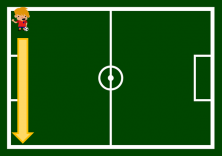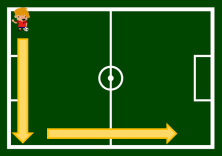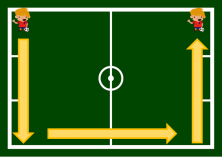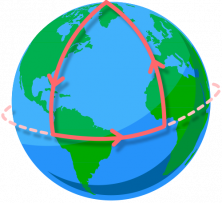You probably already have some idea about what we call a right angle. But, I still would recommend taking a look at some other posts on our blog before continuing, for example, you can review this post about the different types of angles.
Are you ready? Well, let’s expand your knowledge about right angles.
Imagine that…
…you’re at the corner of a soccer field. Now, you walk to the towards the other side.

To continue, you turn 90º and continue walking in a straight line until the end.

Finally, you turn again, making another right angle, and you walk in a straight line until you reach the end.

Have you arrived in a different place from where you originally started? The answer is obvious, no?
So, we could accept that the sequence,
"Walk straight + Turn 90º + Walk straight + Turn 90º + Walk straight"
always brings us to a place that is different than where we started from.
And now imagine that…
you’re a Giant camping all over planet Earth, and you’re following the sequence above. What would happen? Let’s take a look!
Suppose you leave from the North Pole and you walk South. However, when you reach the Equator you turn, forming a right angle, and you walk straight along the Equator. Then, you turn 90º again, in the same direction as before, and continue your journey in the same way. Look at the image below!

Did you notice what happened? You returned to the North Pole, your starting point. But, what happened? We might wonder if these 90º angles on the Earth’s surface are in fact ”right” angles. The answer we’re looking for is that they are, so we will need to look for an explanation elsewhere.
If you look closely, there is nothing inconsiderable between the two examples – the first surface is flat while the second is curved. So, the same sequence of movements,”walk in a straight line” and ”turn 90º”, can lead to different places.
But the interesting thing is to see it backward, in other words, that we can know the curvature of the surface that we are on without having to travel to the Moon to see it from far away. These kinds of arguments are those used by astronomers when they study the properties of the universe.
I hope that you have liked this post and it has encouraged you to continue learning interesting mathematical concepts with Smartick. Log on and register to try our method for free!
Learn More:
- What is a Straight Angle and Examples
- Learn about Angles: Obtuse, Straight, Right and Acute Angle
- What Is an Angle? How Is It Made?
- What is an Obtuse Angle?
- Introduction to Angles: Definition, Parts, and Types







